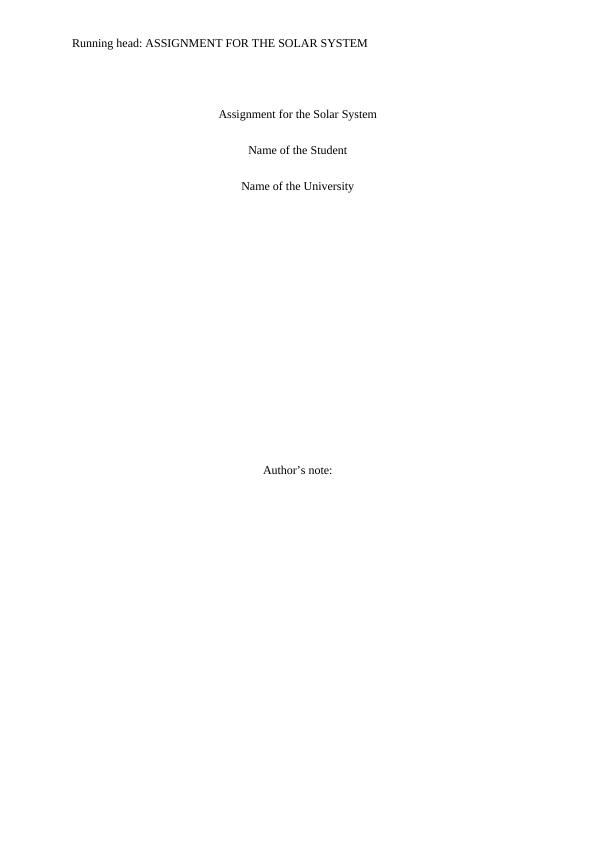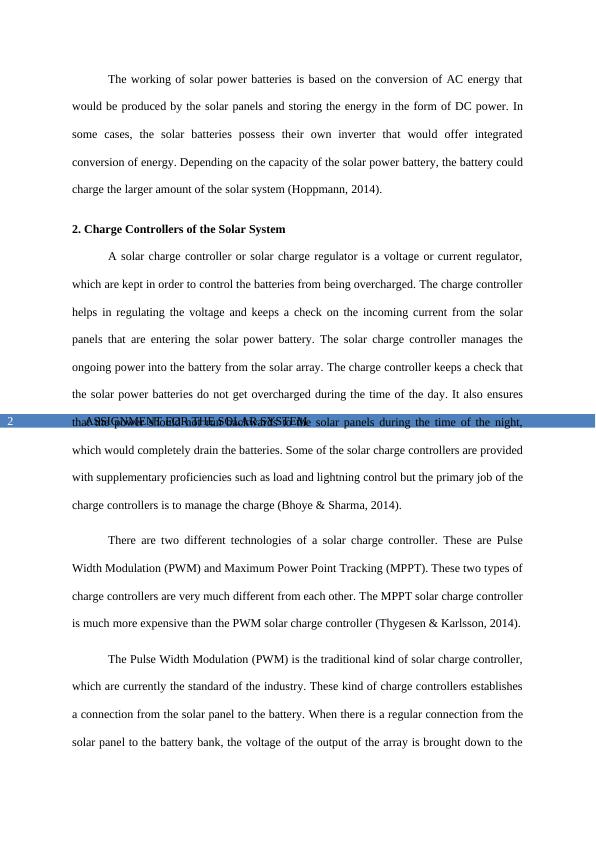Solar System Assignment Sample
13 Pages3727 Words151 Views
Added on 2021-04-16
Solar System Assignment Sample
Added on 2021-04-16
ShareRelated Documents
Running head: ASSIGNMENT FOR THE SOLAR SYSTEMAssignment for the Solar SystemName of the StudentName of the UniversityAuthor’s note:

ASSIGNMENT FOR THE SOLAR SYSTEM11. Solar Power BatteriesA solar power battery is a simple battery which would be charged with energy gainedfrom solar panels. Solar power batteries are those devices, which are capable of producingand store the DC electricity. Solar electric systems commonly make use of batteries that areused as substitutes of solar panels during night or cloudy days. In such cases, the electricitywhich is needed could be easily drawn from batteries instead of getting it from the solararray. The solar array cannot act as a generator because of insufficient sunlight (Budischak etal., 2013). Solar panel systems have emerged as the fastest growing energy sources in severalcountries. The battery is not a vital part of a photovoltaic system. Whenever a solar electricsystem is connected with the utility grid, it does not comprise of a battery system. A backupof power is always needed for certain electric devices (Singh, 2013). Most of the solarelectric systems, which are disconnected from the utility grid possess batteries and chargecontrollers. These are the kind of devices who manage the charging and discharging capacityof the battery. In a solar system, the batteries are typically connected and combined in abattery in order to get the required capacity and voltage. A battery comprises of cells that could be either dry or wet. The wet cell batteries aremostly common than the dry cells which is because of the efficiency of the cost, reliabilityand higher efficiency of performance. Irrespective of the kind of battery used in a solarsystem, the cost of a solar battery is a considerable part of the cost of the entire solar system.A solar power battery which would have a lesser capacity would not be able to the dailyneeds of energy. Hence the entire solar system would become useless. On the other hand, if abattery possesses higher capacity, the cost of the solar system would increase but it wouldalso severely degrade the performance of the solar system (Zweibel, 2013).

ASSIGNMENT FOR THE SOLAR SYSTEM2The working of solar power batteries is based on the conversion of AC energy thatwould be produced by the solar panels and storing the energy in the form of DC power. Insome cases, the solar batteries possess their own inverter that would offer integratedconversion of energy. Depending on the capacity of the solar power battery, the battery couldcharge the larger amount of the solar system (Hoppmann, 2014).2. Charge Controllers of the Solar SystemA solar charge controller or solar charge regulator is a voltage or current regulator,which are kept in order to control the batteries from being overcharged. The charge controllerhelps in regulating the voltage and keeps a check on the incoming current from the solarpanels that are entering the solar power battery. The solar charge controller manages theongoing power into the battery from the solar array. The charge controller keeps a check thatthe solar power batteries do not get overcharged during the time of the day. It also ensuresthat the power should not run backwards to the solar panels during the time of the night,which would completely drain the batteries. Some of the solar charge controllers are providedwith supplementary proficiencies such as load and lightning control but the primary job of thecharge controllers is to manage the charge (Bhoye & Sharma, 2014). There are two different technologies of a solar charge controller. These are PulseWidth Modulation (PWM) and Maximum Power Point Tracking (MPPT). These two types ofcharge controllers are very much different from each other. The MPPT solar charge controlleris much more expensive than the PWM solar charge controller (Thygesen & Karlsson, 2014).The Pulse Width Modulation (PWM) is the traditional kind of solar charge controller,which are currently the standard of the industry. These kind of charge controllers establishesa connection from the solar panel to the battery. When there is a regular connection from thesolar panel to the battery bank, the voltage of the output of the array is brought down to the

ASSIGNMENT FOR THE SOLAR SYSTEM3voltage of the battery. The PWM solar charge controller is good solution at lower cost for theuse in smaller systems. The PWM solutions can perform at a temperature which would rangefrom moderate to high (Kazimierczuk, 2015). The Maximum Power Point Tracking (MPPT) is a recent form of solar chargecontroller, which is majorly used in the recent times. The solar charge controller wouldmeasure the Vmp voltage of the solar panel and then converts the PV voltage to the voltageof the battery (Harish & Prasad, 2013). The MPPT charge controller is the main suitablechoice for their use in higher systems of power. The MPPT charge controller would also beable to function when the temperature of the solar cell would range from low to very hightemperature conditions (Subudhi & Pradhan, 2013). Basic Features of the Solar Charge ControllerThere are many features of the solar charge controller. These are mentioned asfollows:The solar charge controller helps in protecting the battery from excess chargingThe charge controller also reduces the maintenance of the system and thus increasesthe lifetime of the battery.The solar charge controller also provides an auto charging indication.The reliability of the solar charge controller is high.The solar charge controller requires about 10 amp to 40 amp of current for thecharging.The charge controller also monitors the reverse flow of current (Osman, Rahim &Selvaraj, 2013).

End of preview
Want to access all the pages? Upload your documents or become a member.
Related Documents
Photovoltaic Solar Power System Assignment 2022lg...
|21
|3747
|135
Study on Hybrid System with Photovoltaic and Fuel Celllg...
|18
|2508
|255
Battery Back-up Designing Paperlg...
|8
|1939
|213
Types of Power Supply - Assignmentlg...
|12
|3156
|287
Super Capacitor as Energy Storage Devicelg...
|33
|9418
|196
The Stirling Engine Backgroundlg...
|24
|4481
|25
